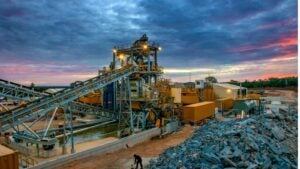Shares of Cameco went up on Tuesday after the U.S. government announced a strategic partnership with Cameco and Brookfield Asset Management, the owners of Westinghouse, to build at least $80 billion worth of nuclear reactors.
The deal is mostly about using Westinghouse technology at several locations in the U.S. Washington will handle the project’s funding and help speed up permits and approvals.
In separate statements, the companies said that the program is meant to help meet the growing need for electricity, including the power needs of AI data centres, and to get the domestic nuclear supply chain back on track.
The announcements did not give a specific build schedule or list of sites, which shows that some terms still need to be agreed upon and approved by the usual parties.
Cameco, one of the world’s biggest suppliers of uranium fuel, will benefit from the partnership for years to come, as it will increase demand for its mining, conversion, and enrichment interests.
It will also benefit from its 49% stake in Westinghouse. Brookfield, which owns the other 51%, gets a partner that is in line with the government to help speed up the long lead times and financing problems that often come up with nuclear megaprojects.
The companies said that each two unit AP1000 project could create tens of thousands of construction jobs and that a national rollout would create more than 100,000 construction jobs.
The news was seen as a sign that the nuclear investment case was correct, which helped Cameco and pushed Brookfield up.
The federal government’s role in financing and approvals is meant to reduce those risks and speed up the process of getting big projects ready for shovelling.
It also shows that the government is betting that big light water reactors can be scaled up reliably to handle more power.
The Westinghouse AP1000 is a Generation III+ design with passive safety features. It has recently gained popularity in other countries and is already being used in new programs in some parts of Europe.
A U.S. program based on that design could make supply chains that can be used over and over again and give utilities and investors a better idea of cost and schedule.
The move comes at a time when energy security and reliability are becoming more important in policy and boardroom planning.
Power buyers are locking in long-term gas and renewable energy supplies, and the U.S. oil export machine is running hot, with global crude oil exports set to break records this year.
It provides a steady, carbon-free base load around the clock that can support intermittent resources and handle the heavy loads of AI compute clusters.
If the new partnership leads to steady orders, component makers and heavy industry could see a cycle like the old utility capex booms, but with a longer tail.
Cameco’s main story now includes more than just the price of uranium. It has the ability to build out over several years because its assets are linked vertically and it has exposure to Westinghouse.
Brookfield’s thesis is based on using its knowledge of project finance and its balance sheet to find value in important infrastructure.
The companies also talked about possible benefits for making things in the US and making the fuel cycle more stable, which are both topics that have gotten bipartisan support.
If we ever do expand into small modular reactors, that would add another option, but for now, the plan is based on large reactors where designs and supply chains are more advanced.
The releases talk about profit sharing plans that are linked to Westinghouse’s growth, but they don’t go into much detail.
Timelines will also be affected by things like site selection, grid interconnections, and long lead items like heavy forgings and reactor coolant pumps.
Still, the agreement between a major U.S. tech company, two Canadian owners with a lot of money, and the federal government is a break from the stop-start pattern that has been common in the sector for the past ten years.




















